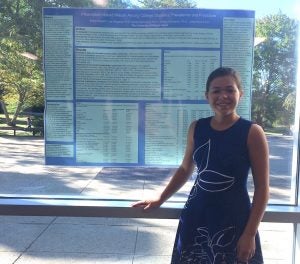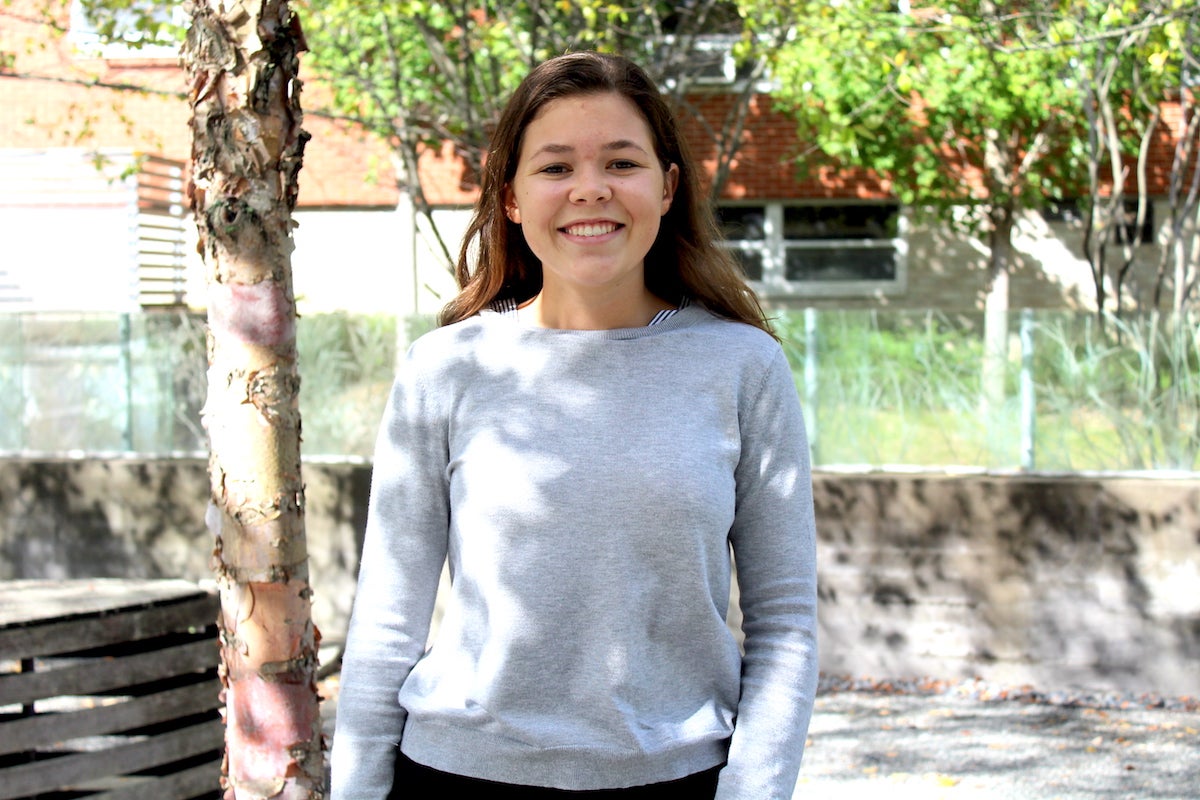Psychology major Emily Shepard’s study wins award at research showcase
About 13 percent of college students acknowledge having misused opioids at some point in their lives, having begun taking the prescription medication either for pain management or for recreation, a URI College of Health Sciences student’s recent study has found.
Psychology major Emily Shepard combined with students at the University of North Carolina at Chapel Hill to examine opioid misuse prevalence among college students at both universities, and determine their motives for misusing, as well as their source of the drugs. For her efforts, Shepard was recently named the winner of the Social Science, Arts & Humanities category at URI’s Showcase for Undergraduate Research, Scholarly and Creative Works.
“Drug use, especially among younger populations, is incredibly interesting because what they’re doing in college and high school really sets people up for the rest of their lives, so looking at the beginnings of this opioid misuse is really important to mitigate future use,” Shepard said. “Opioids are such a prevalent topic. Almost everyone knows someone who’s been affected by the opioid epidemic, so it feels like a very important project.”
Shepard and her partners at UNC conducted a randomized survey of undergrad students at both universities in the fall of 2018. The anonymous survey asked several questions about respondents’ current and past use of opioids, the reasons for beginning and/or continuing to misuse the drugs, and their source of medication.
The self-reported survey indicates 13 percent of students have misused the drugs, just less than 10 percent having done so in the previous month. Most began taking opioids either for pain management or recreation, and the largest source of the drugs were students’ friends and parents, followed by doctors and dentists. Shepard’s study showed no differences among genders regarding opioid misuse.
“We found that the most common predictor was a previous prescription to opioids, or other substance abuse such as alcohol, benzodiazepine and stimulant misuse, and to a lesser extent, marijuana,” Shepard said. “As far as motivation, physical pain was the largest motivator students had, and after physical pain was recreational uses.”
The survey results are in line with Shepard’s hypothesis, though she noted that with any self-reported survey, there is a chance not all respondents are being truthful, raising the possibility opioid misuse is higher among college students. The similarity of the studies at the two universities lends credibility to the numbers, she said.
“The factors were pretty steady over both universities, and since they are in such different geographic locations, it’s interesting that it was so similar,” Shepard said.
The senior psychology major, who also serves as director of Professor Lisa Weyandt’s research lab, began the partnership with UNC through a former student of Weyandt’s who is now a professor at that university. In addition to the opioid study, she is also working with UNC researchers on studies regarding neuroplasticity in children with brain injuries and risky sexual behavior in college students with and without ADHD. Her ability to multitask is no surprise to Weyandt.
“Emily is amazing. She’s been directing my research lab since last year,” Weyandt said. “She is an incredibly hard worker, very organized, and she has exceptional research skills. She could have gone to many, many schools, but we’re thrilled to have her.”
Scheduled to graduate in May 2020, Shepard is applying to graduate schools to continue her studies in clinical psychology. Ultimately, she plans to work with adolescents, particularly those struggling with substance misuse. “So this project ties right in with what I’m interested in,” she said.
 Shepard and her partners are working on publishing their study, hoping to submit it to a major medical journal by the end of the fall semester. She believes her study could provide a road map for future opioid studies and potential solutions, including limiting prescriptions, teaching better pain management techniques, and educating students about the risks involved with opioid misuse to help discourage recreational use.
Shepard and her partners are working on publishing their study, hoping to submit it to a major medical journal by the end of the fall semester. She believes her study could provide a road map for future opioid studies and potential solutions, including limiting prescriptions, teaching better pain management techniques, and educating students about the risks involved with opioid misuse to help discourage recreational use.
“Future research can use that information to create a targeted approach to reduce the amount of opioid misuse on college campuses,” Shepard said. “I really hope it will bring more awareness to how people start misusing opioid. I think there can be such a stigma against people who are misusing drugs and are addicted to these drugs. So seeing where they come from and how this began might lead to more compassion and come up with more targeted ways to mitigate the first introduction to misusing the drug.”

